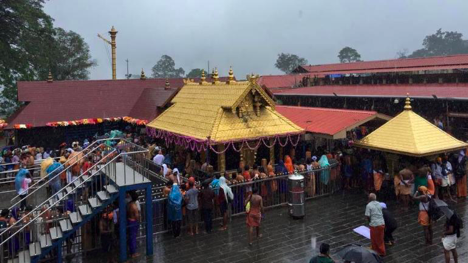By Rameshwari Iyenger works as a Nature Conservationist in Colorado.
One of the temples that have attracted the largest amount of controversy in recent times has been the Sabrimala Temple. The debate over whether women should be allowed to enter the premises of the temple has invoked passion from both, those who feel that such an action would be against the religious sentiments of the community and those who feel that in a democratic nation like India, women should have the same rights as men.
The debate over the entry of women in the Sabrimala temple has remained a contested terrain for a long time. The question of whether this is the opportune time to bring about a transformation in the rituals and allow women to worship freely is not the ambit of this piece. The issue that this article tries to raise is whether the illegal constructions along the Sabrimala and the practice of dumping sewage in the Pamba River that flows adjacent to the shrine are creating health risks for people who are living downstream.
It was in 2014 that an environmental activist who was based in Kozhikode had brought to the notice of the court that a lot of illegal constructions had taken place near the Sabrimala shrine. The point that he tried to assert was that the illegal construction in the forest area and the river basin was leading to unprecedented ecological damages. The point that he was also trying to assert was that while he wasn’t against providing facilities to devotees who visited the temple, he asserted the need for taking care of the ecology as well.
It must be remembered that in 2007, the Kerala government approved a plan by which it would be possible to build public amenities like toilets, cloak rooms and restaurants as long as they did not disturb the ecology. However the debate over whether menstruating women should be allowed to enter into the temple has diverted the public attention from the environmental damage that has been caused in the area because of illegal constructions.

The Sabrimala temle, Kerala is one of the most widely popular temples of South India and is visited by millions ofpeople each year. The temple is located within the Periyar Tiger Reserve in the Western Ghats in Kerala. It is in Sabrimala that the Pamba River originated which takes care of the population living in regions like Pathnamthitta, Alappuzha and Kottayam districts.
In recent times, a great number of illegal constructions have come up near the river and next to where the temple complex is. These illegal constructions made floods worse in the Pamba River. The illegal constructions such as two-storied toilet complexes, hotels, food distribution centres were all destroyed in the recent floods in Kerala.
The river banks have also been damaged because these illegal buildings did not allow the flood water to pass in the rainy season. The illegal constructions have also increased the bacteria count of the river to reach 500 times above normal because the discharge from all nearby buildings is left in the Pamba.
The treatment plant that was assigned the work of cleaning the waters has not yet received its mandatory operational license. Sewage outflow is the main reason why the waters of Pamba are contaminated.
Moreover the collection of waste near the river banks has led to the spreading of many diseases and had made the surroundings a breeding ground for wild boars. The master plan that sought to develop the vicinity of Sabrimala with ecological balance is surely not being followed and the resultant damage is clear.
The ecologically pristine location of Sabrimala contributed so much to the pilgrim’s experience of trekking to the shrine, if the ecosystem is damaged it shall be a shame for us all.
It is time, we as a nation worked on the conservation of ecology, the adherence to ecological guidelines, opt for sustainable developmental options and conserve the ecological abundance that we have been blessed with.
The recent debates over whether women should enter the temple has captured the national imagination, its however time now to think about issues that cannot be ignored long such as the results of illegal construction and ecological damage near the Pamba River next to Sabrimala.













